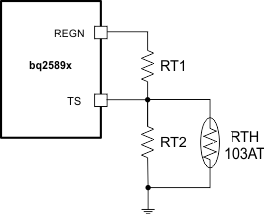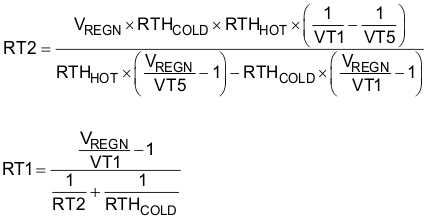SLUSCC5A September 2016 – May 2018 BQ25890H
PRODUCTION DATA.
- 1 Features
- 2 Applications
- 3 Description
- 4 Revision History
- 5 Description (continued)
- 6 Pin Configuration and Functions
- 7 Specifications
-
8 Detailed Description
- 8.1 Functional Block Diagram
- 8.2
Feature Description
- 8.2.1 Device Power-On-Reset (POR)
- 8.2.2 Device Power Up from Battery without Input Source
- 8.2.3 Device Power Up from Input Source
- 8.2.4 Input Current Optimizer (ICO)
- 8.2.5 Boost Mode Operation from Battery
- 8.2.6 Power Path Management
- 8.2.7 Battery Charging Management
- 8.2.8 Battery Monitor
- 8.2.9 Status/Control Outputs (STAT, INT and DSEL)
- 8.2.10 BATET (Q4) Control
- 8.2.11 Current Pulse Control Protocol
- 8.2.12 D+/D- Output Driver
- 8.2.13 Input Current Limit on ILIM
- 8.2.14 Thermal Regulation and Thermal Shutdown
- 8.2.15 Voltage and Current Monitoring in Buck and Boost Mode
- 8.2.16 Battery Protection
- 8.2.17 Serial Interface
- 8.3 Device Functional Modes
- 8.4 Register Maps
- 9 Application and Implementation
- 10Power Supply Recommendations
- 11Layout
- 12Device and Documentation Support
- 13Mechanical, Packaging, and Orderable Information
Package Options
Mechanical Data (Package|Pins)
- RTW|24
Thermal pad, mechanical data (Package|Pins)
- RTW|24
Orderable Information
8.2.7.5.1 JEITA Guideline Compliance in Charge Mode
To improve the safety of charging Li-ion batteries, JEITA guideline was released on April 20, 2007. The guideline emphasized the importance of avoiding a high charge current and high charge voltage at certain low and high temperature ranges.
The device continuously monitors battery temperature by measuring the voltage between the TS pins and ground, typically determined by a negative temperature coefficient thermistor (NTC) and an external voltage divider. The device compares this voltage against its internal thresholds to determine if charging is allowed. To initiate a charge cycle, the voltage on TS pin must be within the VT1 to VT5 thresholds. If TS voltage exceeds the T1–T5 range, the controller suspends charging and waits until the battery temperature is within the T1 to T5 range. At cool temperature (T1–T2), JEITA recommends the charge current to be reduced to at least half of the charge current or lower. At warm temperature (T3–T5), JEITA recommends charge voltage below nominal charge voltage.
The device provides flexible voltage/current settings beyond the JEITA requirement. The voltage setting at warm temperature (T3–T5) can be 200 mV below charge voltage (JEITA_VSET=0). The current setting at cool temperature (T1–T2) can be further reduced to 20% or 50% of fast charge current (JEITA_ISET bit).
 Figure 14. TS Resistor Network
Figure 14. TS Resistor Network
 Figure 15. Charging Values
Figure 15. Charging Values
Assuming a 103AT NTC thermistor on the battery pack as shown in Figure 14, the value RT1 and RT2 can be determined by using Equation 2: :

Select 0°C to 60°C range for Li-ion or Li-polymer battery,
RTHT1 = 27.28 kΩ
RTHT5 = 3.02 kΩ
RT1 = 5.24 kΩ
RT2 = 30.31 kΩ